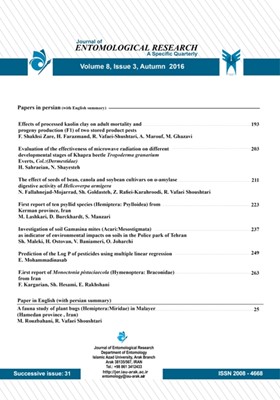Effects of processed kaolin clay on adult mortality and progeny production (F1) of two stored product pests
Subject Areas : entomology and othea arthropodsFarshid Shakhsi Zare 1 , H. Farazmand 2 , R. Vafaei-Shoushtari 3 , A. Marouf 4 , M. Ghazavi 5
1 - Department of Entomology, Faculty of Agriculture, Islamic Azad University, Arak, Iran
2 - Iranian Research Institute of Plant Protection, Agricultural Research Education and Extension Organization (AREEO), Tehran, Iran
3 - Department of Entomology, Faculty of Agriculture, Islamic Azad University, Arak, Iran
4 - Iranian Research Institute of Plant Protection, Agricultural Research Education and Extension Organization (AREEO), Tehran, Iran
5 - Iranian Research Institute of Plant Protection, Agricultural Research Education and Extension Organization (AREEO), Tehran, Iran
Keywords:
Abstract :
The insecticidal effect of processed kaolin (Sepidan®) and its influence on progeny production (F1) of Tribolium confusum (Coleoptera: Tenebrionidae) and Oryzaephilus surinamensis (Coleoptera: Silvanidae) were investigated under laboratory conditions (25±1C°, 65±5% R.H, in dark). Seven to 10 day old of each species were exposed to kaolin at five concentrations (1000, 2000, 3000, 5000 and 10000 ppm) and their mortality was recorded after 3, 7, 15 and 30 days, at three replicates, separately. The results showed that mortality of adults increased significantly as the concentration rates and exposure duration increased, (p<0.05). Complete mortality of O. surinamensis occurred at 10000 ppm after 15 days of exposure time. The highest mortality of T. confusum (98.3%) was at 10000 ppm, 30 days after treatment. According to bioassay tests, adults of O. surinamensis were significantly more susceptible to kaolin than T. confusum at various time intervals in any concentrations. The Progeny production tests showed that, 100% reduction of F1 occurred at 5000 ppm for confused flour beetle and at 2000 ppm for saw-tooth grain beetle. Although, processed kaolin clay (Sepidan®) has a potential to kill stored product beetles, because of high concentration of application applied in, it cannot be used alone. However, due to its good effect on progeny production (F1), it could be used in combination with other control methods.
_||_


